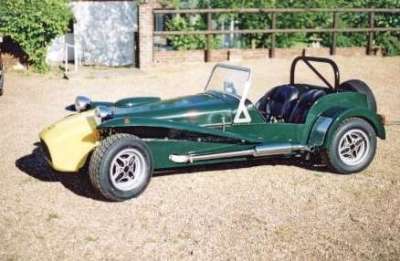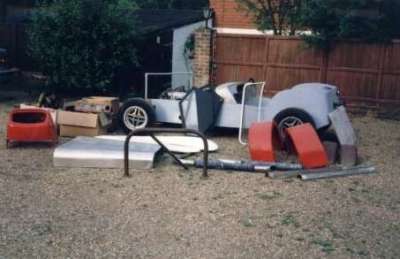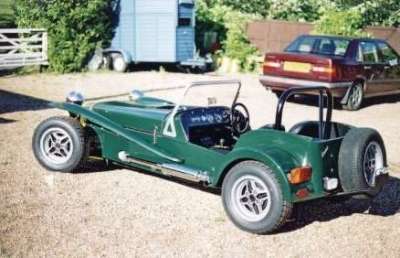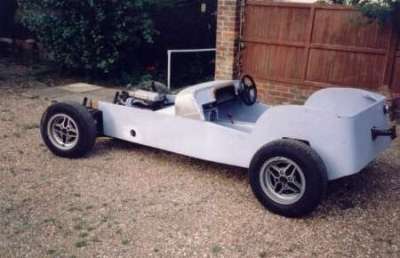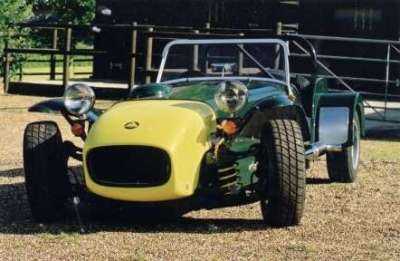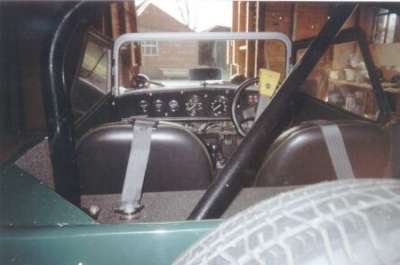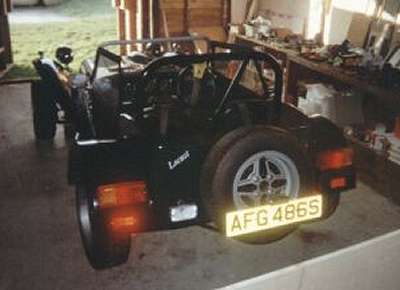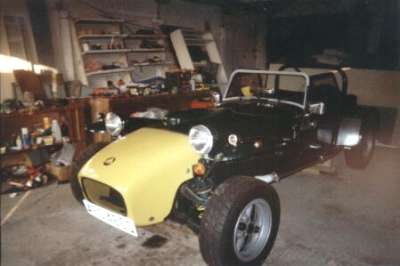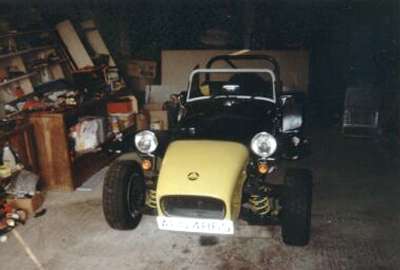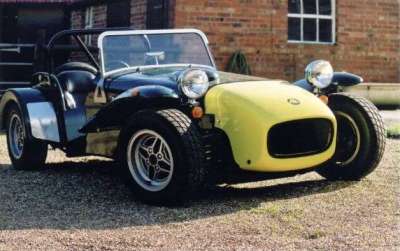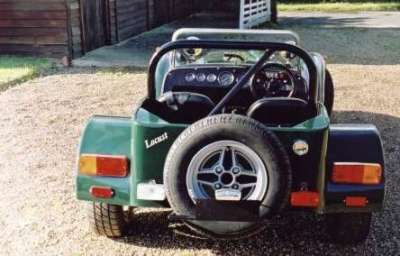 | ||
| Search |
|
|
ANOTHER LOCUST
IS BORN The story must start in the middle of June 1999, sitting in my shop one morning, sifting through a "give-a-way" magazine at the cars for sale section. My colleagues and I spotted the Ad. "Locust 7 replica kit car, Ford 1300 engine, gearbox, half built, all bits to complete car. £ 750.00" "LOCUST?" . The Friday-Ad is as good at spelling, as your are, Chris!!, my colleagues quipped. Now up to this moment in time I had only dreamed of building a car, but all the conditions were in place to conceive such an idea. I had moved into a farmhouse two years previously, and had completed all the obligatory works on the place eg. painting, decorating and keeping the wife happy. The house had an old barn which would be the ideal place to take on such a project. I had always loved the look of the Lotus 7 style, back as far as my teens after watching Patrick McGoohan in the TV series and thinking that it was the closest to a "racing car" for the road as you could get. So the idea of building a car was slowly churning around in my head as the day went on. Come the afternoon, curiosity got the better of me, so I made the call. Have you still got your car for sale? Yes I have, came the reply. How far is it built? It's a rolling chassis, with the engine and gearbox in place, wheels, tyres, boxes of bits, wings, mudguards etc . Ok, can I come round tomorrow and have a look?
I rushed off down to the local newsagent to buy a Kit Car Mag in order to "gen" myself up on Kit cars. The car was at the guys place of works, which transpired was a Fencing manufacture about 10 miles away from my home. "The cars in the barn, and it's a bit dusty" he said after the initial introductions. He slowly opened up the double doors of the barn and propped them open to reveal the car. The car was covered in a layer of sawdust and in darkness. O what a joy to be hold!!! The car was indeed as he described, a rolling chassis, on wheels, gearbox and engine all in place. The body panels all cut out, screwed and fix in place. The clam wings, windscreen, rear mudguards, pedal box, back axle, instruments, wiring looms, the lot were all in cardboard boxes. The story was, that he had the car six months with the intention of completing the build but had not had the time with a new baby on the way. Another Locust is born. Chris Laycock tells his build story. Page 8 The original owner had brought the chassis, wings, etc. from W.R.V. back in 1996 along with a Ford Escort donor vehicle and had spent three years building the Locust, but had to stop through ill health. All the paper work was with the car including the donor vehicle logbook, copies of all parts bought, assembly manual, the reading of which provided entertainment.
The deal was struck at £ 650.00 cash and arrangements made to transport the car back to my place. The following day, I logged on to the W.R.V. internet site for more information. I down loaded all the current prices etc. and quickly realised that I had brought a bargain. I hired a car trailer and arranged to collect the car the following evening. Returning to my house I promptly started to off load the car when my wife came out the house and utter the immortal words, "If you think I am going to get in THAT coffin, you can think again." I laughed and explained "it's not finished yet". I pushed the car into the barn and set about looking through the six large cardboard boxes of bits which came with it. It was like being at a Auto jumble sale. There was a mini heater, three wiring looms, de-misters trunking, wiper motor, Speedo, rev counter, temp gauge, petrol gauge, pedal box, radiator, switches, nuts & bolts and loads more. The next day was Sunday and after bolting down my breakfast I was out into the barn with my wife's words echoing "I suppose that's the end of any more work around the place now you've got that b----y car" I jacked the car up on to two pairs of car ramps in order to take a good look under and around the car. A phone call to the original builder the previous evening got a load of answers to umpteen questions. It transpired that he was in to building Autocros s Minis, and had purchased all the Locust parts from W.R.V. but hurt his back in a rallying accident . The engine, gearbox and back axle had all been stripped down and re-built using all new parts as required. New disc brakes, wheel bearings and shock absorbers had all been fitted. The chassis had the Cortina front suspension using coil over shocks, and red oxide paint over the chassis followed by an enamel paint. Page 9 The steering rack was from the Escort with a rack extension rod with an adaptor to the track rod end. Propshaft had already been shortened to fit the rear axle. He had cut all the body panels, glued together and strengthened them with right-angle aluminium on the joins and used a waterproof sealer. A look just under the car revealed what a good job he had started. All the brake pipes were in place up to the engine bay, as was the petrol tank (mini van type) and petrol pipe. First job was to fit the pedal box in place. Second job install electric's. No problem. Into the box of bits to locate the pedals. Now as I am 6'4" and by sitting in the car (I would be doing a lot of this as the weeks went by) I figured out that the pedal box would need to fix on to the vertical footwell panel with the tops of the pedals, after they had been cut down, poking out of the top footwell panel. The brake would work on a push action towards the bulkhead and the clutch using a bracket into the engine bay.
Three weeks later the clutch and throttle linkage was in place and working. Next the electric's. Great fun. Bought the KIT CARS electric book, very useful. Into the box of bits to find the wiring loom. There were three looms, all with slightly different bits on. Now havi ng purchased the Haynes manual on the Mark 2 Escort, enlarging the wiring diagrams, colour coding with felt tip pens it soon became clear that I had two types of looms. The best one was from the sports model, and after laying the loom around the car I found the best route. Many more weeks passed by, weekends spending 3-4 hours and in the evenings 1-2 hours just figuring out where all the wiring needed to terminate. By now it was approaching Christmas 1999 and I realised that I was not going to meet the dreaded deadline for the SVA exemption. More on this subject later. An exhaust system was required before the firing up of the engine. Looking through Europa part catalogue, I came across the Chromozone system which comprised of down pipe and exhaust box and ninety-degree tail pipe.( the end of which was SVA compliant) By this time into the build, I wanted to retain the 1960's theme, and had decided on the colour was to be British racing Green with Yellow nosecone, and chrome exhaust. So £ 105.00 was sent off to Europa as an early Christmas present to myself and within 4 days it duly turned up. I offer up the exhaust box and down pipe to the left hand side of the car and made a template from cardboard for the bend taking the pipe through the side and on to the four branch manifold. A trip down to the local exhaust centre was to follow to obtain the correct bend. The pipe was bent as per. the template and fitted like a glove. What a star!!!!! The complete side pipe and ex haust box was fitted without a hitch and really looked the D.B's. Next the radiator, and in to the boxes of bits again. The rad obviously had come from the Escort Mk. 2 and on closer inspection revealed the top housing was Page 10 made of brass. I wire brushed off the old paint to revel the brass in all its splendour. A coat of matt black paint made the rad. look like new. I offered the rad. into the brackets and after checking that the nosecone would fit over, I drilled the fixing holes. Back to the boxes of bits to find hoses. There were none in there. Again, I made up templates out of cardboard and noted the bore sizes required and set off for a trip down to my local car accessory shop. Three hours later, after driving all the assistants mad, I emerged with heater hoses and radiator bends. Back in the barn, armed with all the hoses, I set about joining them all up. The next day was new Years Day, so out to the car with water and anti-freeze, I filled the radiator. Connected the battery, put in two gallons of leaded petrol, took out all sparking plugs and turned the key. A few churns on the starter motor ensured the mechanical petrol pump had filled the carburettor and so quivering with excitement the sparking plugs were re-fitted. I leapt back into the car and with great trepidation turned the key!!!!! The engine turned over but kept spitting back through the carburettor and obviously not firing. What's gone wrong? Sticking valves, hole in piston, plug leads not in correct order, bad electrical contacts etc. Where do you start. Let's start with the plugs! They were wet with petrol. I turned the engine over with all the plugs out, and they all had lovely healthy blue sparks. Grabbed the Haynes manual to check the firing order. All plug leads are on their correct plugs and in the distributor correct. Timing!!! I turned the engine over with a spanner to line up the timing marks and whipped off the rocker box cover. The valves on No.1 cylinder were both closed. Back to the distributor to see where the rotor arm was pointing. It was 180 degrees out!!! The guy had obviously put it back wrong after stripping the engine down. Out it came, back into the correct position, re-gapped the points and with light bulb adjusted the timing. Back into the car, turned the key. BINGO!!! The engine bust into life. It sounded fantastic. Tears of joy weld up in my eyes. The entire car had came to life, it was a living, breathing, smelling joy. I savoured the moment. Seating on the floor pan, grasping the steering wheel, I closed my eyes and pictured myself driving the Locust on an early sunny Sunday morning, changing gear in the early morning mist!!!! That's not mist, that's steam. I quickly switched off, jumped out the car and to my dismay the radiator had more holes in it than a second-hand dartboard. I went back to my house to consolidate myself in a coffee and to allow the system to cool down. Returning to the car, I drained off the remaining water and removed the radiator. It was well beyond repair. All that lovely brass I had lovingly polished. A new radiator was called for. I had also noticed that the accelerator pump gasket on the bog standard Page 11 carburettor was leaking, so a trip to "Formula One" carburettor specialist shop in Brighton was in order for a replacement gasket set. This turned out to be a stroke of luck, because as I was ordering the gasket set, I noticed in the window a radiator. I inquired if they sold radiators as well as parts for carburettors. No, came the reply, "It was part of a display." What car is it off? I enquired. A Mark Four Cortina came the answer. Now as luck would have it, I had the old rad in the back of my car and with further ado, I grab mine out the boot. The new rad was the same width but about 2" higher complete with a Kenlow fan, all of which was band new. Do you want to sell it ? Yes, came the reply. How much? £20.00. OK. I have never parted with money so quickly. I rushed home from work that evening and out to the Locust clutching the new rad. It fitted perfectly into the uprights. Will the nosecone fit over. Yes!!! 1" to spare. A new flexible top hose was the only requirement. I filled up the rad with water again, back into the car and turned on. It burst into life on the first turn and was soon up to temperature. No leaks. Surprisingly there was no sign of overheating, oil leaks etc. The original owner had done a good job (apart from the distributor out by 180 degrees) on the engine and coupled with the fact that the engine had not been run for some four years. By now it was the end of January, and with the engine now running, this spurred me on to complete the car in time for the summer. Throughout the next few evenings, I replaced all the gaskets in the carb, and also replaced the engine oil and filter. The engine did have new oil in it before I started it, but now it was running OK I decided to replace with new, just to give it a birthday. On with the rest of the build. The mini heater was modified to fit on to the bulkhead with the vents up to the windscreen to comply with the SVA test. At this point I decided not to fit an expansion tank as no signs over overheating had taken place. I could always fit one at a later stage. The gear lever extension was the next project and armed with templates a visit to a friend who builds Stock Cars was in order. A rose joint, metal brackets and thread cut on the end of the gear stick, two evenings of work and the linkage all worked. By the middle of February, the dashboard was all cut out, covered in black vinyl leatherette, all dials in place and connected up to the electrics. The transmission tunnel was covered in the same fabric but I could not decided on the seats. Looking through the EUROPA catalogue I spotted in the Corbeau range, the ideal seats I thought. As the gap between the transmission tunnel and the sides was only 40 cm the Clubstatic seat @ 38 cm wide fitted the bill. The cost was £131.00 each but a call to Corbeau factory at St.Leonards-on-Sea saved £46.00 on each seat. So the next big job was the fitting of the Aluminium. One 8 x 4 sheet of 22 gauge was purchased for £25.00 along with contact adhesive. A space heater was rented for the weekend to heat the barn, and I cut out the Aluminium with a jigsaw after clamping it to 6 mm plywood sheets in order to achieve a clean cut. No problems here. I started gluing on the back panel as it looked the hardest. Again no problems. It bent very smoothly a round the back sill and was pinned underneath the following day as per the "Manual" to allow the adhesive to harden. On to the two side panels, butt joined the section just above to wheel arch and smoothed down, again the overlap was pined over the following day. I t really did start looking like a car at this point. The hardest part was shaping the 1" half round aluminium beading around the cockpit area as I wanted this all in one piece. It took a further full day to bend and shape this but it was well worth it. Rear Wings were tackled the next weekend. After deciding which was the left and right hand sides as there was a difference, it was obvious that at least 6" needed to come off the rear of each wing to look correct over the wheel. With the angle grinder, I cut 6" off the rear of each wing, drilled holes and bolted same to the car. A further day was spent with the front clam wings offering them up to the car and fixing them on. At last it looked like a car. Holes in the rear wings were cut to receive the rear light cluster and wiring. The Windscreen fitted with a little bending of the aluminium supports and holes drilled to take wing mirrors. The finishing touches to the bonnet shape were done with the catches fitted everything was then removed ready for painting. It was now mid March. I decided to remove the clam wings in order to paint them separately. A call to a friend in a body shop to arrange the painting and the parting of £500.00 was arranged. I had come this far with the car and did not want to muck up the paint job as glass fibre and aluminium are possibly the worst surface to spray for an amateur. I transported the car again on the trailer to his body shop with a promise that it would be ready in two weeks. Five weeks late he called to say that the car was ready. I was gob smacked when I saw the car. It looked a million dollars. The nosecone was Lotus Yellow and the rest of the body was British Racing Green. Are you pleased with it? he enquired. I was lost for words. For the second time in my life I parted very quickly with hard cash.
With the car now back at the barn, all the finishing touches took place. Black cord carpet from my carpet shop had been ordered and was trimmed in, the seats fitted, roll bar painted and bolted in place. The 7" Chrome headlights, winkers and rear lights all followed. It was time to think about the SVA TEST. By now it was the middle of April 2000 and time to book the SVA test. Now as I live on the south coast near Eastbourne/Brighton the closest Test centres were between 60-70 miles away. Not the best of distances to travel in a vehicle that had not tested on the road, and a 22 year old engine that had been stripped down, no number plates etc. I opted for the Test centre at Gillingham in Kent, some 60 miles away and decided that the only way to get there was to hire the car transporter again. With all the forms filled in, I sent off my £ 165.00 cheque along the all the paper work. With in four days I received a postcard informing me to phone the Test centre in order to book a date. On phoning , I was informed that they were very busy and the next available date was the 1st June, some six weeks away. Was I ever going to get the car on the road for the summer? (What summer) The time was booked for 1.30pm which would give me loads of time to undertake the journey. So with six weeks to kill, I carried on with the finishing trims which as it happened, highlighted two glaring fault's with the car. I required a push on chrome trim to cover the windscreen surround in order to increase the edge radius to comply with the 2.50mm.
I had seen an advert in KIT CAR Mag for the self adhesive chrome strip at PILGRIMS the Cobra kit car manufactures near Brighton and a trip over there proved very helpful. The chrome strip was only £ 5.00 per.mtr and 3.00mtrs was purchased. What lovely cars the Cobra's are and obviously we got talking. "Have you put a handbrake warning light
on the dashboard?" I am now armed with sketch plans of what I need. "By the way, have you got a collapsible
steering column or collapsible steering wheel?" On the way home my mind was racing. Just over
four weeks to go to the test and two major details to sort out. On to the cars spares shop for new brake pipes. That only took two evening to sort out including the wiring to the low brake fluid sensor. The steering column, I decided was not worth the hassle of striping out and opted for the collapsible steering wheel. A look through "Demon Tweeks" catalogue under Moto-Lita steering wheels produced a 13" wheel to fit onto the Cortina spine complete with collapsible boss all for £ 85.00. Guess what!!!!! Delivery four weeks. That will be tight. Two weeks to go to test date. I really need
four new tyres on the car and a test run somewhere. I looked through
all the booklets on the about the test and in particular the leaflet
SVA2 "A guide to Amateur built vehicles". "You will be allowed to travel to and from the test station without the vehicle having been registered and if necessary, to and from a garage or other place where modifications are done to enable compliance with the requirements. You are responsible for ensuring that you have insurance cover and that the vehicle complies with the requirements of the Road Vehicles (Construction & Use) Regulations and the Road Vehicle Lighting Regulations when driven to and from the test location. Otherwise, driving an unregistered vehicle on a public road is an offence" So there it was in black and white "to and from a garage or other place where modifications are done" All I need was to obtain insurance cover, book a standard MOT, more really for a pre-test, get new tyres and at the same time could get the headlights set up. Back to the KIT CAR Mag for Insurance brokers.
After two or three calls I went for "BRACKFORD BLOOR &
Co in Ellesmere Port. ( 0151 356 8776 )
What a lovely sunny day it was.(Must have only
been one of six that year.) The Locust started on the first turn
of the key, and I edged it out of the barn and into the courtyard.
I left the engine running in order to warm it up and decided to
snap off some photo's. With the photo shoot completed, I eased my
6'4" frame back in the car. I eased off the handbrake and with
great intrepidation selected first gear and positioned the Locust
at the entrance ready for the road. Lets test the brakes, I thought, nothing behind. It did take along time to stop, but consider they were new discs and pads I guessed they just need to bed in. Off I went again, no vibrations, gear changes OK, engine sounding sweet as a nut, not weaving from side to side, so all those month of testing in the barn had paid off, but was this early days!! Three miles later, everything working OK, water temp just right, not overheating, I came to the village. Brakes beginning to work more efficiently now. Out through the other side of the village with five miles to go to the garage with the appointment set at 10.30. One mile on and the engine started coughing
and spluttering and finally stopped. I coasted over on to the grass
verge and pulled to a halt. I could not believe it!!! I had put in over 2 gallons of leaded petrol
in the car over the months I had spent working on it and it obviously
had been used up. Back at my house, bid farewell to the district
nurse, grabbed a can of leaded petrol, and strolled over to my normal
car. The plan was to drive to the Locust, leave my Volvo in the
lane, continue on in the Locust, return home, cycle back to my Volvo,
and put cycle in boot, return home. Four new "Yokohama's" tyres were fitted on the RS Wheels with the best of the old, to the spare wheel. On then to the ramp for the MOT. The headlights were slightly out of aliment, but adjustment with spanner soon bought them back into their correct position. The handbrake was super efficient and the front brakes passed all OK. A small tweak on the mixture was required to bring the exhaust emissions in line with the tolerance set for an engine of 1978 vintage. That was about it, half an hour later it had passed with honours through the standard MOT test. During the test I had a least twenty questions fired at me by a similar number of mechanics asking things like, "Is it a Caterham, Westfield, Dax, Robin Hood etc, how long did it take you to build, my mates building one of theses" and so on.
Armed with new tyres and MOT I moved towards the petrol pumps. The tank filled up to about 22 litres, approx five gallons which with the one gallon I had put in previously worked out at six gallons approx total. Range at 30 miles to gallon about 180 miles. Even the petrol gauge read full. Driving back home the car felt even better with the new tyres and the reassurance that it had passed the MOT. Back at home safely with the Locust I pulled the bicycle out the shed in order to retrieve the Volvo. Two flat tyres. Great. One hour later both punctures had been fixed and I was puffing and weaving my way to collect the car on the bike. I checked the Locust over for water and oil leaks etc, one last polish and I was ready for the SVA test. The 1st of June dawned, the day of the test and still the collapsible steering wheel had not turned up. The plan was to collected the car transporter which was about 15 miles away, so maybe the wheel would be delivered on my return. One hour later with the Locust now sitting on the transporter and half an hour to go before I was due to leave, the postman turned up. Nothing!!! I set off for the estimated two hour run to Gillingham, now resigned to the fact that the Locust was going to fail on the steering wheel. Several other niggling worries went through my mind as well, like the decibels on the exhaust, no guard on the exhaust box, sharp edges etc. The journey up went like a dream and only took
one an half hours, so I had time to book in, unload the Locust and
last minute check on all the lights. I was then called into the
queue between all the juganoughts ready for the tester to appear. I replied " Well, the whole car is a rip-off
of a Lotus, isn't it?" That did not go down to well. My hand when down to the front of my trousers to double-check. What was he on about! The large nut running through the Cortina wishbone did not conform with the 2.5mm. radius nor did the adjuster track rod nuts. I was certainly off to a good start. As the examiner went over the car more silly
things came to light. At this point he inquired how long the car had taken to build and where did the kit come from. I detected that he was starting to warm to me. On to the lights, left winker, right winker,
front and rear, headlights, beam, stoplights, all OK. "No. Is there a problem." "No. It's of very good standard" came
the reply. I must be on a roll. I had used the design weights figures from Bob Fenton's car ( Taken from the "Locust Position" Mag of Spring 2000) simple because it is impossible to drive any where with the car not having number plates/MOT etc.to get it weighed. Front Axle 362 kg. With Driver 378 kg He use this to arrive at the efficiency figure for the braking system and it passed. On next to the exhaust emissions. The engine required to be held at about 2500 revs and a reading was taken. A tweak on mixture was in order to achieve the pass figure. This did somewhat puzzled me as only one week earlier I had gone through the MOT test and the emission was a passed OK. I can only put it down to the test machines and slightly different standard's. Moving on, the next test was the Noise. A microphone was placed about 50-cm. from the end of the exhaust pipe and I was told to rev the engine up to 3000 and hold it there. An Ok reading of 96 decibels, 101 or under is the pass. I asked him about the side exhaust not having a cover and his reply was "that fine, it not compulsory" "I need to get in your car now please" he smiled. He jumped in as if he was a veteran at , picked first gear, and shot off for a trip round the test centre. It was quite nice to see the car being driven by some one else. " Your Speedo works OK. I see on your form that you have had it re-calibrated, but I did need to check that it worked. All the mirrors are Ok. Can you please take your car back to the trailer and call in the office so I can make my notes." I loaded the Locust back on the trailer and
wandered forlorn to the office. " Cover the nuts with cut down rad pipes, re-position the winkers, cover the bonnet catches with covers and it will pass. We know you all take the these bits off afterwards" Two days later, back at home, I set about covering the wing brackets and track rod nuts, with cut down radiator pipes held on with plastic clips. I used the plastic caps off spray can's which were dome shaped, to cover the large wishbone nuts and glued them on.
I bought a pair of motorbike winkers in a tear shape and fixed them on top of the clam wings. By this time the steering wheel had turned up ( It arrived one hour after I had departed for Gillingham.) but the spines were wrong. A new boss was delivered three days later complete with padded cover for the spokes, SVA compliant. A phone call back to the test centre the next day to book the re-test on the next available date which was on the 19th June. Car loaded on the trailer, and all set for the
second run up to Gillingham. The same examiner appear from the offices with all the old fail sheets and promptly went into the list. " I am very glad to say your car has passed this time Sir." I could not stop grinning from ear to ear. With the now coveted MAC certificate, I rushed
back home, dropped of the Locust, returned the trailer and armed
with all the paper work, decided to call into the Brighton registration
offices to register the car for the number plates. "I see you do not have a currant MOT certificate
Sir" Ok was his reply, we will get in touch with you to arrange the examiner to look at the vehicle. Is that done here I enquired. No, we inspect it at your premises. Four days later, I had still not received a phone call, after leaving my mobile number, works number and home number, so I called in. "We don't seem to have your MOT certificate
Sir". I heard this one before. "A new chassis/body shell from a specialist
kit manufacture is used and two major components from the donor
vehicle. An age related registration mark will be assigned based
on the age of the donor vehicle and an SVA certificate will be required
to register the vehicle. An MoT certificate will be required at
every re-licensing thereafter." As I had the original Logbook from the car, including the engine/engine No. plus the gearbox and back axle, I was looking for an age related number plate the SVA MAC was all that was required. The clerk made a phone call to the DVLA and spoke to Mrs Bowler who informed him that I was correct and an MoT was not required. 10 out of 10 to the Magazine. So when are you now likely to inspected the car? I enquired. The inspector will be in your area on September
29th. No sir, you cannot drive the car on the public highway, what you can do is trailer your car over here on a given date and we can then inspect it. When is the next appointment day? Next Wednesday @ 10.15 am. Ok I'll be there. What a palaver. I booked the hire on the trailer yet again and
trundled the Locust the 25 miles over to Brighton to the Vehicle
registration offices. All OK sir, we will inform you of the registration number. How long? Takes about 10 days at the moment. Was I ever going to drive this car in the Summer. AFG 486S had finally been born. I purchased new number plates that day and rushed
home that evening to hang them on. Two miles down the road, I could smell petrol. Off came the bonnet to locate the problem. It was a sticking float. I remove the top of the carb and sorted out the float, reassembled and was soon underway. On to the main road and a chance to do more than 35 mph. The smell of country air really added to the whole experience. Even without the side screens the wind was not to bad. The only fault I had, was that I had to look over the main windscreen. I needed to remove some of the seat padding and I could attend to this later. I drove the nine miles into Eastbourne for a pose up the sea front. I stop for an ice cream, and within seconds was surrounded by people asking me what is was, how long did it take to build, etc, etc.
I decided to call into my mother, to show her
the car as she had only seen it in the early stages. My mum lives
in a retirement home and is 86 years of age. Have a look out your window, mum, I'm in the car!!! She is on the second floor and was down in 3 minutes, followed by at least ten of her friends. After about five minutes she asked if she could get in the car. I explained to her not to hold the windscreen and to step into like your were getting into a bath. Two seconds my mum was in, big broad grin on her face and all her friends laughing and joking. I climbed into the driver seat and with waves and laughter from the crowd pulled away. I drove back up to the sea front with my mum lost for words. I stopped for my second ice cream of the night. By now it was twilight and after dropping my mum off I needed the headlights on. Thank goodness they worked. Heading back home with the headlights on there was no different to a normal car. All ready for a weekend spin, I was now a fully paid up member of the silly grin club. Come the Sunday morning, I fixed the side screens on and removed about 3" of padding from the seat squab. What a difference, no buffeting and I was now looking through the windscreen. In the afternoon I drove over to Brighton, to
attend a Classic Car Show and won first prize in the Kit Car section.
A bottle of white wine. What a nice time I had, all petrol heads
talking about their cars. I have now covered 2265 miles up to October 2000 with only problem being the starter motor nuts working loose one day. Project for 2001 is to find a 5-speed gearbox as the 4 - speed @ 80-85 mph is showing 4200 revs on the Speedo. I understand that a mark nine Sierra box will bolt on without too much trouble. Things to watch out for on the SVA test is the
up-date's they keep bring out ever month which can alter your goalpost's
and not all test stations are the same standard. It is their interpretation
of the rules.
| ||||||||
 |
|
|

